African American Soldiers fight off 24 Germans with Bolo Knives during World War I
“There wasn’t so much to it…”
In this article, we continue from Part I of African American Knife-Fighters of Old New York.
In May of 1918, during World War I, two soldiers named Henry Johnson and Needham Roberts—both African Americans from New York State—were awarded “one of the greatest honors that any American soldier has received in the World War,” the French War Cross (Croix de Guerre). The Cross had been bestowed on the men for “bravely routing,” according to various accounts, between 24 and 36 Germans, much of it in hand-to-hand combat with the clubbed rifle and knife.
“Our colored troops display a special aptitude and affection for this weapon…”
The men had used bolo knives, based on the Filipino model, which had been adopted by the U.S. military, as explained by the Bourbon News on July 26, 1918:
The bolo knife which Henry wielded so well weighs one pound and three ounces without its scabbard, and has a broad 14-inch blade. It is sharpened to a razor edge, and near the end runs abruptly to a thrusting point. But one of its chief virtues as a small-arm is its cleaving power. Most of the weight of the knife is distributed along the back of the blade. Americans first ran up against the bolo in the Philippines…It was up among the Moros that it was developed for war purposes. In the underbrush it proved a very terrible weapon, as many a trooper found to his cost. A stroke in the tropical night just one counted for a major American, casualty. After, a while our soldiers—found there was no particular knack in the Malay use of the bolo they could not master. Then they began to capture bolos. And so, after the war ended, bolos kept coming back to the United States as souvenirs.
But it was not until 1910 that the war department tried the experiment of issuing the bolo knife as a regular part of the American equipment. It was used and tested by our men in Mexico, but there it was employed chiefly as a tool rather than a weapon. It was not until our khaki-garbed boys went down into the French trenches that the bolo knife proved its right to be considered “the last line of defense” and a life-saver to the man who unsheathed it. Our colored troops display a special aptitude and affection for this weapon. The white fighter is inclined to rely upon his automatic pistol in an emergency at close quarters, but the colored man in uniform take as naturally to the bolo knife…
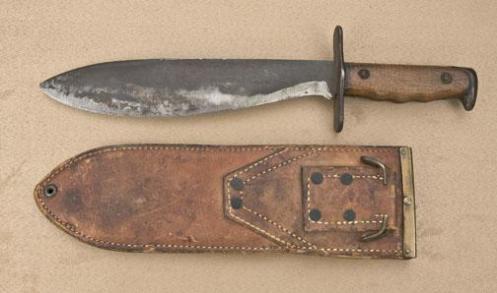
Above: WWI U.S.-issued bolo knife by A. C. Co. of Chicago. Source: http://www.icollector.com
“Staggering to his feet he unsheathed his bolo knife and sent the blade slicing through the skull of the man whose hands were at the throat of the prostrate Roberts. Turning he drove the knife through the stomach of another.”
A glowing account of Johnson’s and Robert’s exploits with the knife appeared in the New-York Tribune, on May 26, 1918, and gives an overview of what happened, as well as how their feats were viewed by American society at the time:
WHEN two privates of a New York negro regiment won the French war cross and the highest praise of the commanding generals a few days ago, they merely up held a tradition too little known for gallantry and heroism by negro fighters in the American forces for the last half century. From the time when Shaw enrolled the first black regiment under tho Stars and Stripes till today, when the sons of the freedman are worthily holding a share of the West front line, the black regiments have, carried their full share of all the burdens and dangers faced by the American armies. Against the Indian, in Cuba, in the Philippines and along the border the record has been the same, and it is one to be envied. Battling with twelve times their number of Germans and cut off from supports, two negro infantrymen of the old 15th New York Regiment, and the 369th, performed as stirring a deed of gallantry as ever graced the home roll of an army.
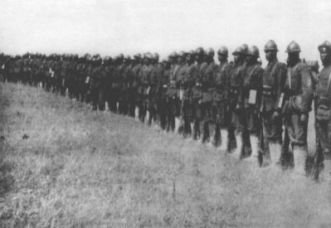
Above: Colonel Hayward’s 369th Regiment (formerly the 15th Infantry), in which Johnson and Roberts served. From “Kelly Miller’s History of the World War for Human Rights” Source: Gutenberg.org
The black warriors are Private Henry Johnson and Needham Roberts. The negroes, armed with rifles, hand grenades and bolo knives, in the early morning of May 15 were at an important post fifty yards nearer the enemy than the main line of resistance. In the pitch darkness Johnson heard slight sounds behind him and caught sight of a man crawling on the edge of the barbed wire with which the post was hedged about. His cry of alarm was heard back in main post and star shell was sent up. Almost simultaneously a volley of German grenades was hurled at the two soldiers.
Instantly Roberts fell with three wounds on his arms. The right arm was rendered useless, but with the left he groped around for his basket of grenades and although lying on the ground began throwing them. Johnson fired his rifle at the nearest adversary. The German fell, but another jumped toward Johnson and was almost upon him when the colored boy swung his clubbed rifle and sent the butt crashing through the enemy’s skull. Then he turned toward Roberts, who was battling with three Germans, one of whose hands was clutching at his throat. At the same time a dozen others had penetrated the wire, fired three revolver shots, and Johnson went down with three bullet wounds in the left leg, the right hip and the right forearm. Staggering to his feet he unsheathed his bolo knife and sent the blade slicing through the skull of the man whose hands were at the throat of the prostrate Roberts. Turning he drove the knife through the stomach of another.
What happened then seems a bit hazy, for Roberts had fainted and Johnson was weak from loss of blood. However, the German raiding party fled and after them Johnson hurled his last grenade and saw the explosion scatter the hindmost German in pieces.
French General Praises Negroes
When the French general commanding the division received the report of the American officer in charge he declared it was much too modest to signalize so daring an exploit. His own view finds expression in the following citations issued in the divisional order of the day:
“Private Henry Johnson, finding himself on night sentry duty and being attacked by a group of more than a dozen Germans, put one hors de combat with rifle shots and two others with knife cuts. Although wounded thrice by revolver bullets and grenades at the start of the fight, he went to the help of, his wounded comrade as the latter was about to be carried, off by the enemy and continued the struggle until the Germans were forced to flee. He gave a magnificent example of courage and energy…”
HENRY JOHNSON’S ACCOUNT
“They knocked me ’round considerable and whanged me over the head, but I always managed to get on my feet again…”
Johnson himself gave an account of the combat, in an interview published in the New York Tribune on February 13, 1919:
A much-abashed black man confronted the reporters when the sergeant had responded to his colonel’s summons, “Tell these gentlemen about your fight with the raiding party,” said the colonel.
“Yes sir,” replied Johnson, but he hesitated and stammered a little.
“Go on. Henry.”
“Yes sir, but ain’t so much to tell about.”
“Sergeant Johnson is modest,” interrupted the colonel, “but he’s one of the finest soldiers in the American army. There’s none finer.”
“There wasn’t nothing so fine about what I did,” the sergeant protested. “Just fought for my life. A rabbit would have done it…
“Well, anyway, me and Needham Roberts was on patrol duty on May 15,” he resumed. “Round midnight the sergeant brought two green men to relieve us. ‘Good Lord,’ I says, surely you’re not goin’ to put those fellas here. There’s German snipers been shooting round this way tonight, and we’ll all be killed unless you have men on the job what knows their rifles.’ He said it was my imagination, but anyway he took those green men away and left me and Needham at the post…
“Somewhere ’round two o’clock I heard the Germans snipping our wires out in front and calls for Needham Roberts. When he came I told him pretty near all the Germans in the world was creepin’ over our way and he’d better pass the word along to the lieutenant. Roberts had just started off when the snippin’ and clippin’ of the wires sounds closer and I let a hand grenade fly. There’s a yell from a lot of sure surprised Dutchmen and then they start firing. I hollered to Needham to come back. Right offen the reel he got shot through the arm and hip and I saw the best thing he could do would be to lay down in the trench and hand me up them grenades.
“‘Keep your nerve,’ I told him, ‘and give me them grenades just as fast as you can pass ’em up, ’cause I’m gonna need them in a hurry.’
“Well, he kept handing ’em to me and I kept throwing them and the Dutch men kept squealin’, but just the same they kept coming on, too! When the grenades was all gone I started in with my rifle. That was all right till I shoved an American cartridge clip in it. It was a French gun and it jammed, so it wasn’t no more use thataway.
“There was nothin’ to do but jump into them Germans an’ club ’em. I guess I cracked four or five of their heads with the butt of my gun when it busted. Then I took out my little ol’ French bolo knife and sailed into ’em, rippin’ away just as hard as I could.
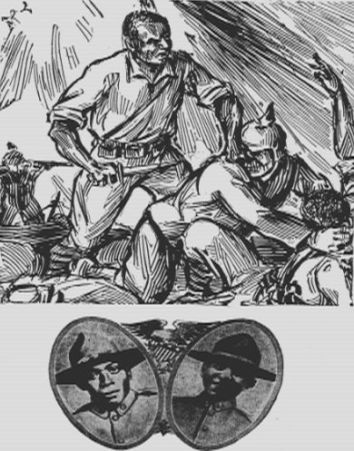
Above: Illustration of Johnson and Roberts, from “Kelly Miller’s History of the World War for
Human Rights” Source: Gutenberg.org
“One of ’em hollered. ‘Rush him! Rush him!’ Just then I thought I’d do a little rushin’ myself, so I picked out an officer, a lieutenant, I guess he was, and made for him, swinging my bolo. I got him and I put some more. They knocked me ’round considerable and whanged me over the head, but I always managed to get on my feet again. That fight lasted about half an hour and I was wounded in a couple of places when they got help out to me. That’s about all. There wasn’t so much to it.”
There was this much to it: That when dawn broke they found Henry Johnson had killed four Germans and wounded thirty-two so severely they were unable to follow their fleeing comrades when the relief force came up.
According to the New York Sun, in an article published on the same day,
By official verification Sergeant Henry Johnson, Albany “coal merchant,” killed single handed certainly four Germans, perhaps more, and wounded twenty four gray clad warriors. The number of Germans wounded by little Henry Johnson is put at twenty-four in his lonely night fight because twenty-four is the number actually accounted for officially. But officers and men on board the Stockholm yesterday, who were close by at the time of the mighty private war waged by Henry Johnson, say that they are morally certain that single handed he killed at least six of the enemy and wounded thirty-two.
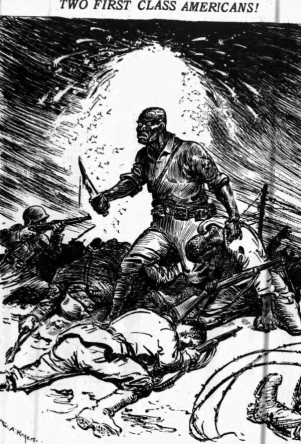
Above: Illustration published May 22, 1918 in the New York Herald, commemorating Johnson and Roberts
Those who enjoyed this article may also be interested in:
Part 1: African American Knife-Fighters of Old New York
and
The Greatest African American and Afro-American Martial Artists in History


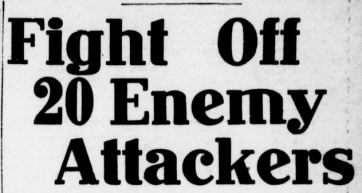
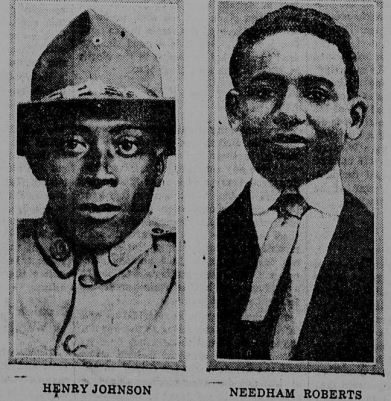
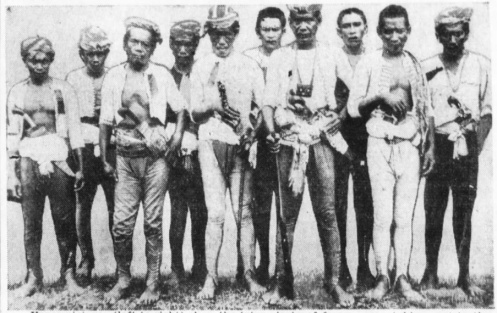
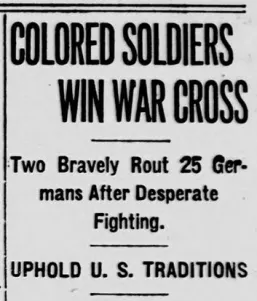
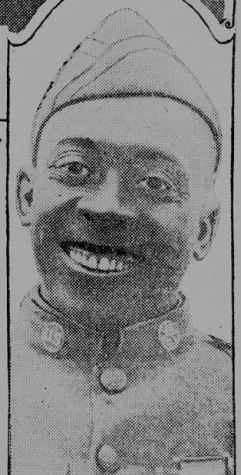

Reblogged this on THE MARTIALXCHANGE.
LikeLiked by 1 person